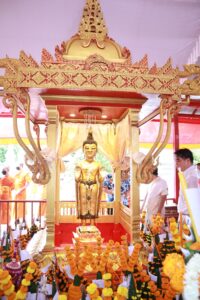Xieng Thong Temple in Luang Prabang has officially opened the Ho Phra Man shrine, inviting locals and tourists to pay their respects to the sacred Phra Man Buddha statue as part of the annual Lao New Year (Pi Mai) tradition.
The Phra Man Buddha, considered the second most revered Buddha image in Luang Prabang after the famed Prabang statue, is normally housed in a shrine at the rear of Wat Xieng Thong and is visible only from a distance. However, in line with tradition, the statue is brought out for public viewing and merit-making ceremonies during the New Year celebrations.
 This year, the temple is allowing visitors to perform the traditional water-pouring ritual over the sacred image from 22 to 26 April, between 8.00 am and 5.00 pm each day. The ritual follows the return of the Prabang Buddha to Ho Prabang, in accordance with beliefs that it is inauspicious for both powerful images to be publicly displayed at the same time.
This year, the temple is allowing visitors to perform the traditional water-pouring ritual over the sacred image from 22 to 26 April, between 8.00 am and 5.00 pm each day. The ritual follows the return of the Prabang Buddha to Ho Prabang, in accordance with beliefs that it is inauspicious for both powerful images to be publicly displayed at the same time.
As part of the ceremony, the Phra Man Buddha is carefully carried out from its chapel and paraded three times around Wat Xieng Thong. It is then placed in a pavilion in front of the temple, where devotees pour scented water over the statue – a symbolic act of merit-making and spiritual purification.
The Origins of the Phra Man Buddha: A Sacred Mystery
The true origins of the Phra Man Buddha remain a subject of legend and speculation, with two distinct stories still told today, both steeped in mystery and reverence.
One version of the story says the Phra Man Buddha arrived in Luang Prabang in 1968, brought by a group from the Lao Theung hill tribe. The statue is in a standing position, which holds special meaning in Luang Prabang. People believe that standing Buddha statues have the power to call for rain and help those who pray for children.
In 1979, Luang Prabang experienced a severe drought. Remembering this belief, village chiefs from Khili, Xieng Thong, Phon Heuang, and Ban Kang consulted with the head monk of Wat Xieng Thong at the time. Together with the head of Wat Sensoukharam, the monks decided to bring the Phra Man Buddha out for a merit-making ceremony.
Soon after the rituals were performed, rain began to fall, according to the story. This marked the first time the Phra Man Buddha was honoured with a water-pouring ceremony, a tradition that has continued every year since.
Another story tells that the Phra Man Buddha dates back approximately 700 years. According to legend, it was crafted in Burma (modern-day Myanmar) and was originally intended to be returned to the Hanthawaddy Kingdom after its completion.
The statue was placed on a raft and transported along the Mekong River. However, as it reached the waters near Luang Prabang, the raft mysteriously stopped in the middle of the river and could not be moved forward, no matter what the soldiers tried.
The person escorting the statue then prayed: “If the Buddha does not wish to return to the Hanthawaddy Kingdom, please choose a temple to remain in Luang Prabang.”
At that time, the city was home to over 100 temples (compared to around 60 today). Head monks from various temples came forward to invite the Buddha image ashore, but all attempts failed.
Then, the head monk of Wat Xieng Thong approached with a prayer of his own. To everyone’s amazement, the raft, carrying the statue, floated to Xieng Thong temple on its own.
The Buddha image was then brought to Wat Xieng Thong and locals under the guidance of a Buddhist monk constructed what is now known as the Phra Man House.
The Phra Man Buddha is made of gold and adorned with nine-colored jade. It is decorated with intricate ornaments, including a jeweled belt buckle and bracelets. The statue weighs 75 kilograms, the altar 20.5 kilograms, for a total weight of 95.5 kilograms.



